Abstract
Budd, Kenneth (The University of Michigan, Ann Arbor), Alfred S. Sussman, and Frederick I. Eilers. Glucose-C14 metabolism of dormant and activated ascospores of Neurospora. J. Bacteriol. 91:551–561. 1966.—Dormant and activated ascospores of Neurospora tetrasperma, incubated in C14-labeled glucose, absorb and metabolize this sugar. At the same time, up to 55% of the CO2 production from endogenous substrates is quenched, whereas total CO2 production is unchanged. Glucose-carbon appears in CO2, lipids, and ethyl alcohol-soluble and -insoluble material in both dormant and activated ascospores, although the proportions entering these fractions differ in the two groups of spores. With few exceptions, the identifiable intermediates of glucose metabolism are the same in dormant and activated ascospores, indicating that the principal pathways may be identical. During glucose metabolism, dormant ascospores accumulate a nondialyzable, ethyl alcohol-soluble polymer, or polymers, which is either absent from activated spores or present in much smaller amounts. This material contains glucose, ribose, and at least nine amino acids, and may represent precursors of more complex cell material which accumulate because of an enzymatic deficiency in the dormant spore. Radioactivity is incorporated into all fractions of the dormant spores and into CO2 without a noticeable lag, indicating that most, if not all, of the enzymes for glucose utilization are present. A lag in incorporation is observed in the activated spores, which most probably is due to rapid endogenous production of glucose from trehalose, resulting in dilution of lable. After absorption of labeled glucose, two pools of trehalose are found in dormant spores, one of which is extractable without breaking the spores, and the other, only after the spores are disintegrated. The widely differing specific radioactivity of the two pools indicates that these are separated in the intact spore.
Full text
PDF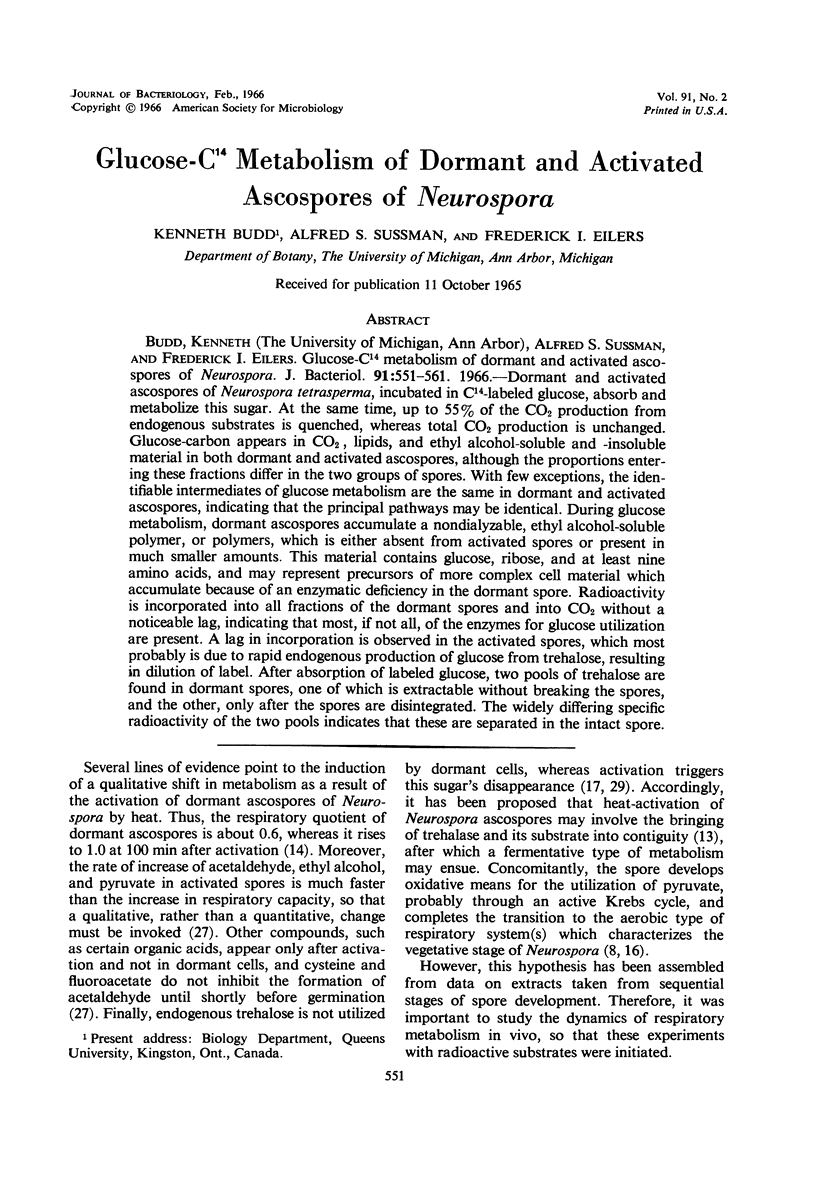
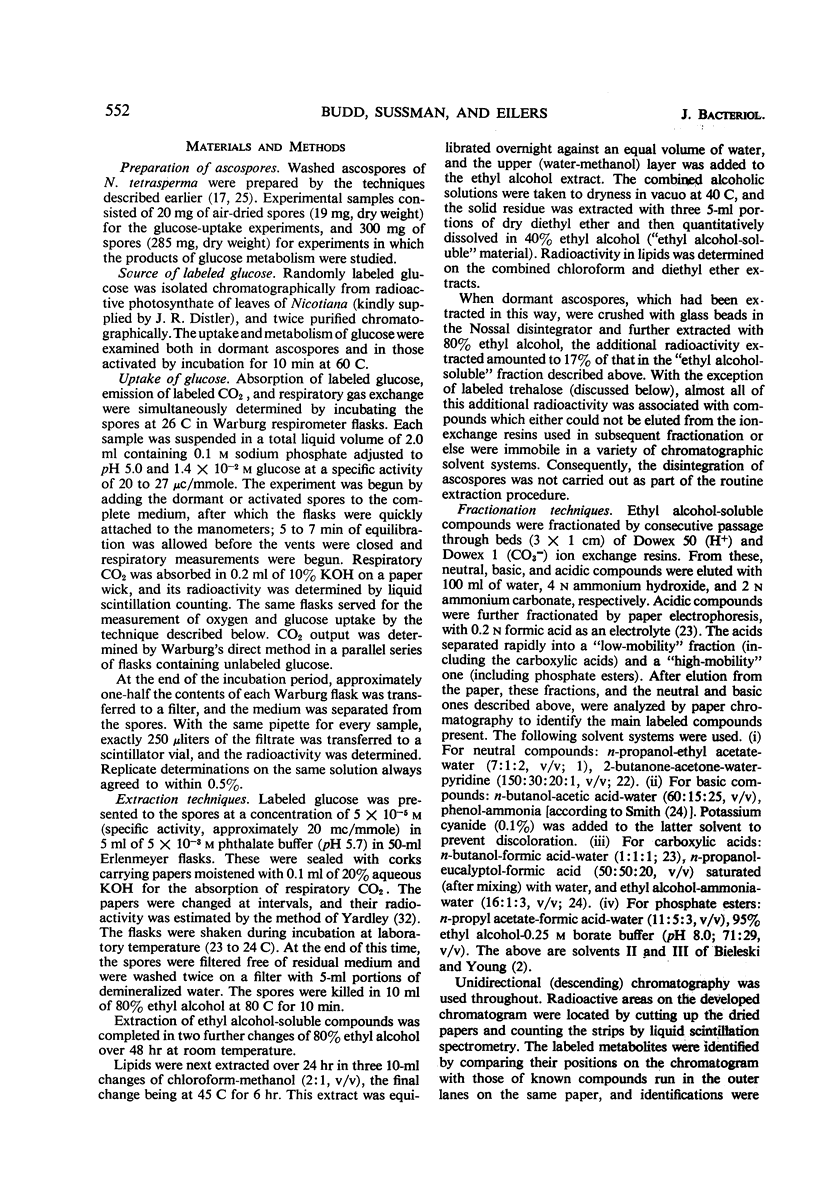
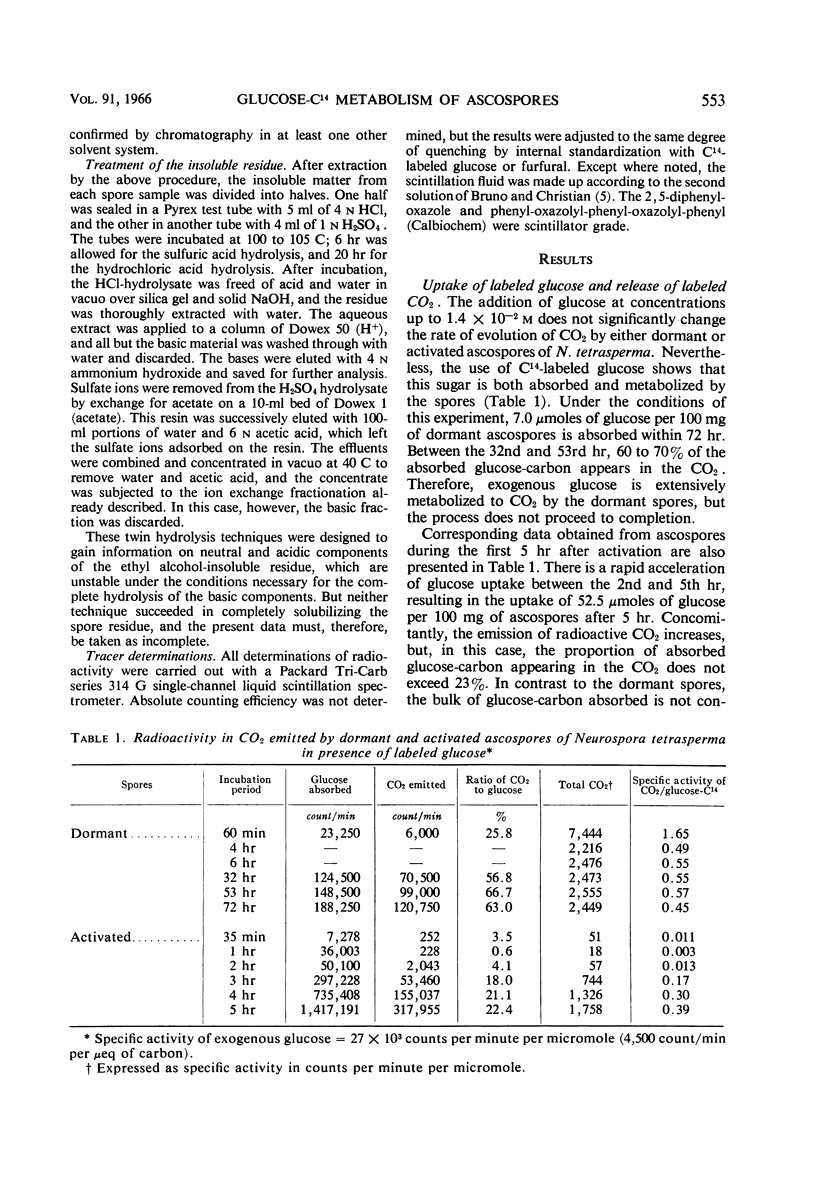
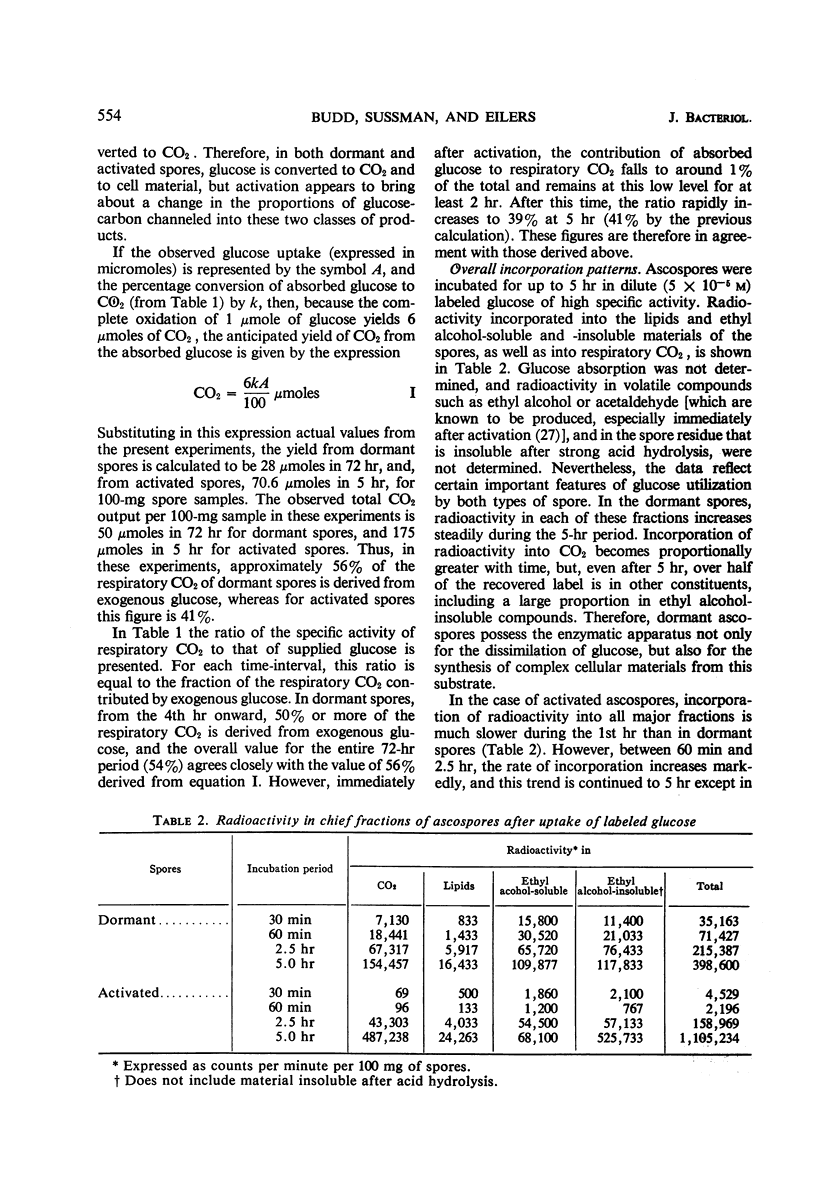
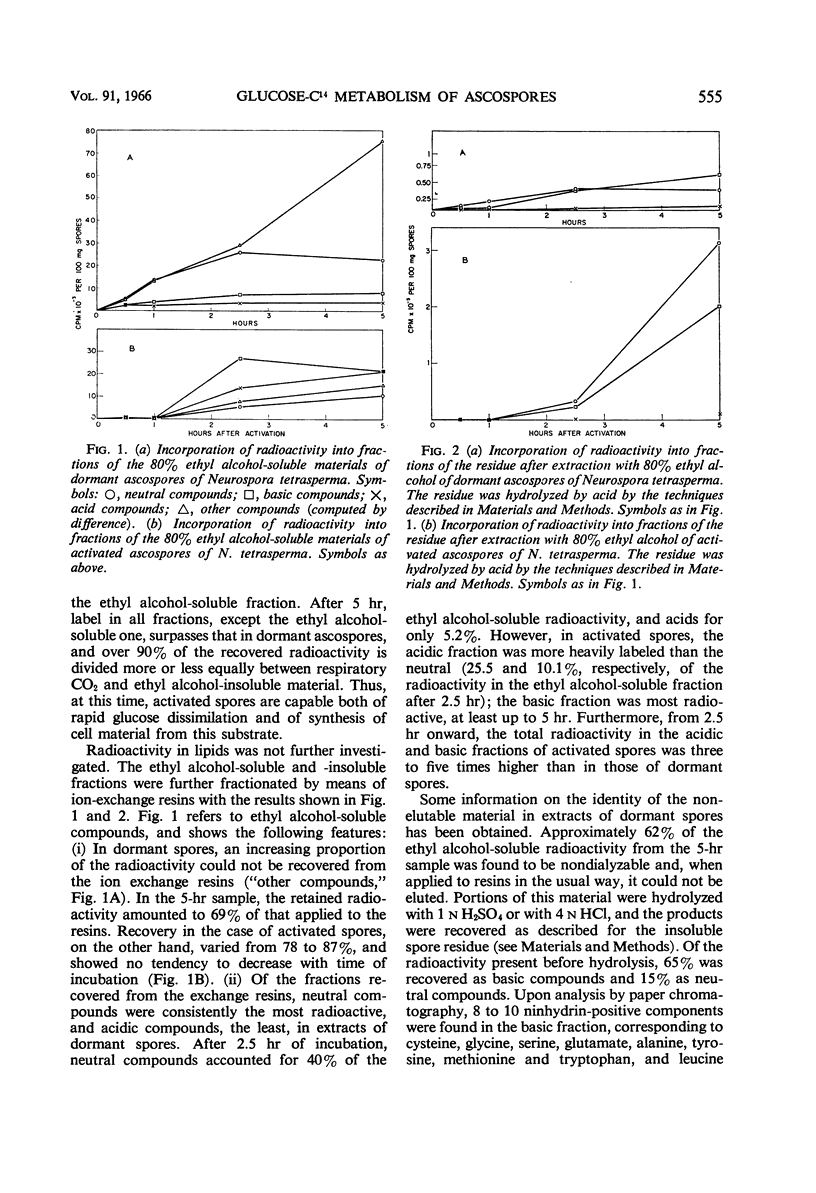
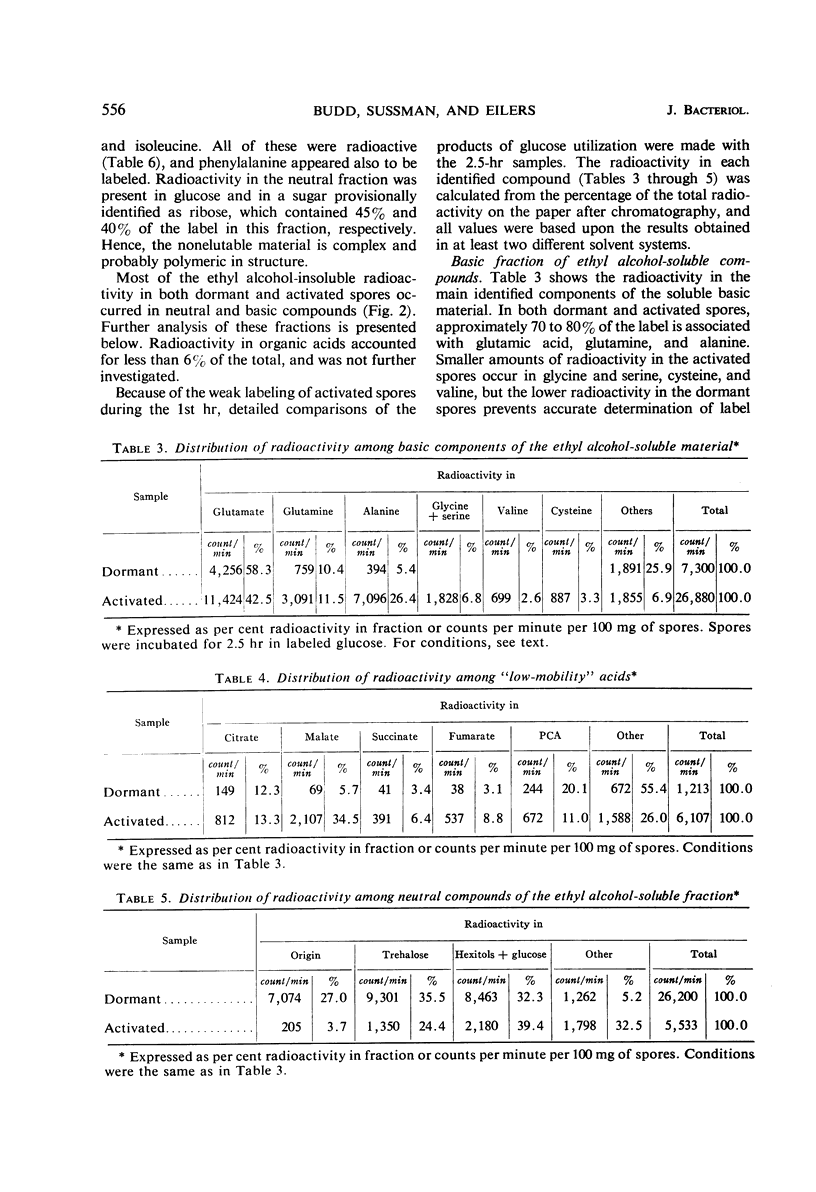
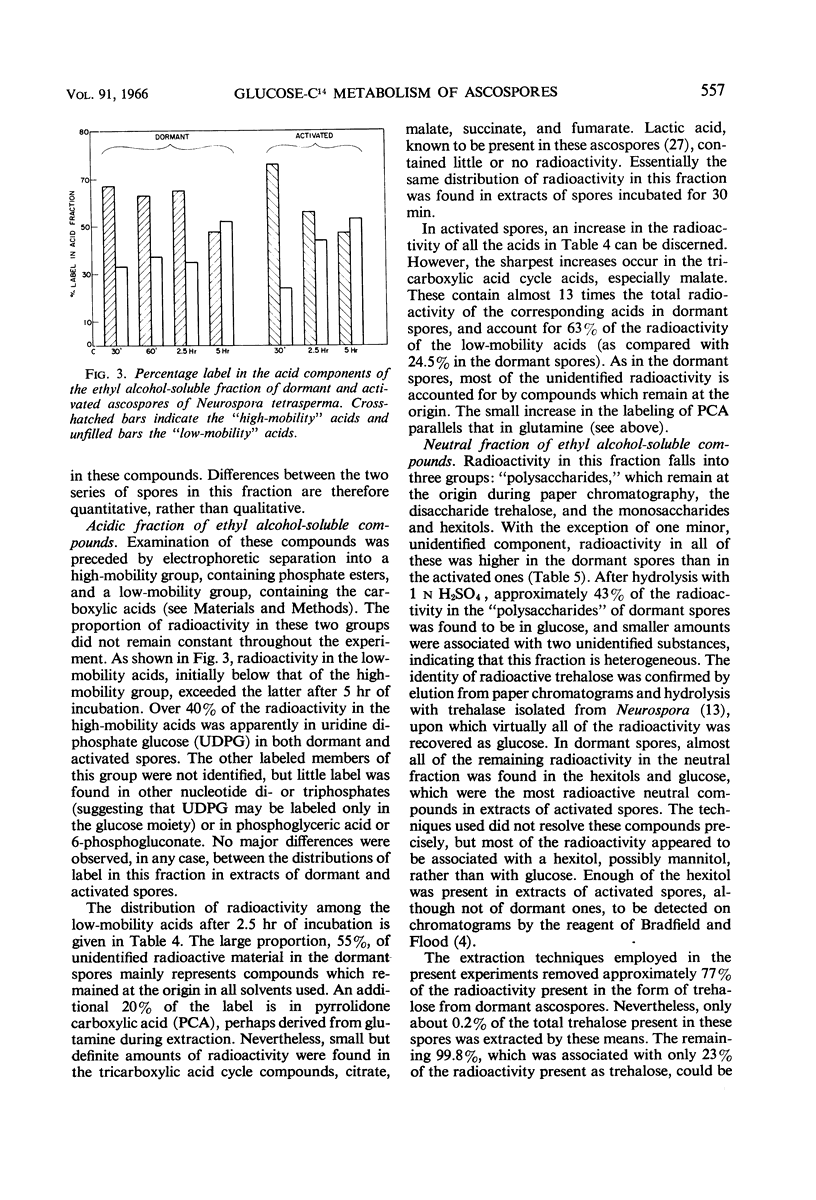
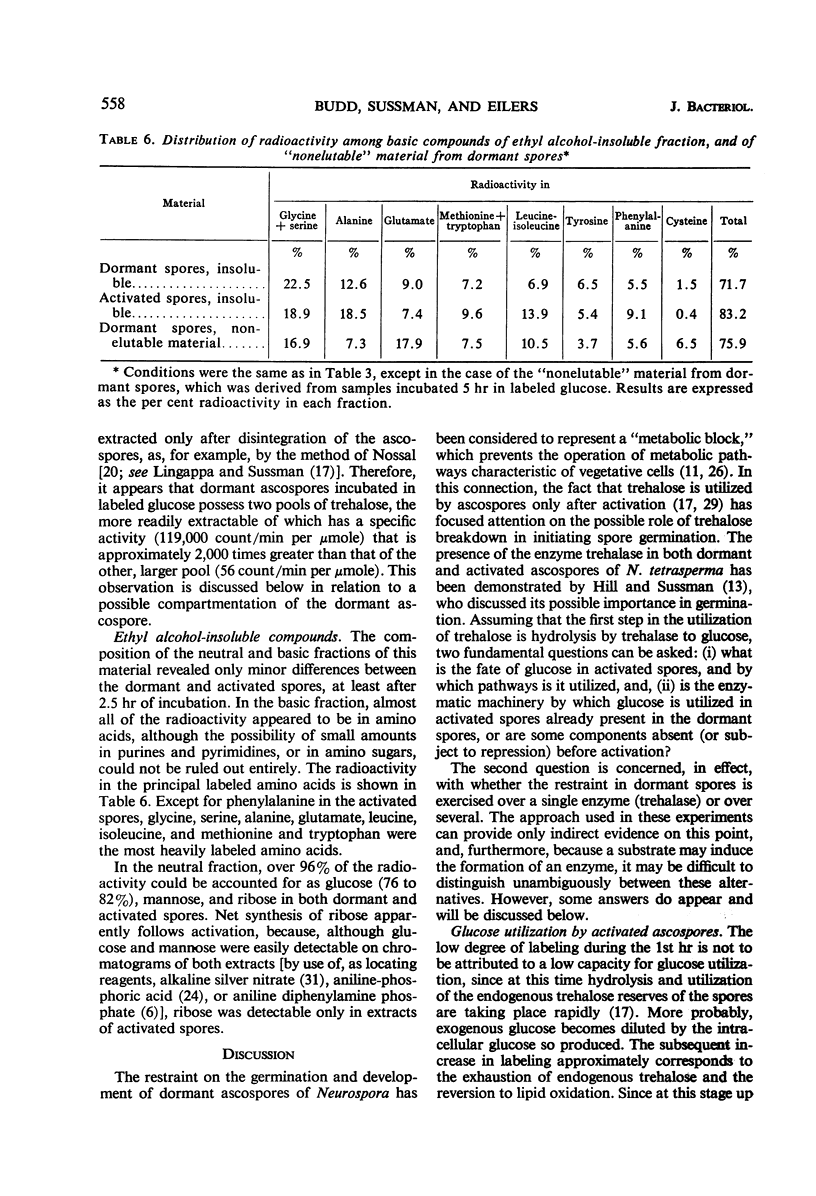
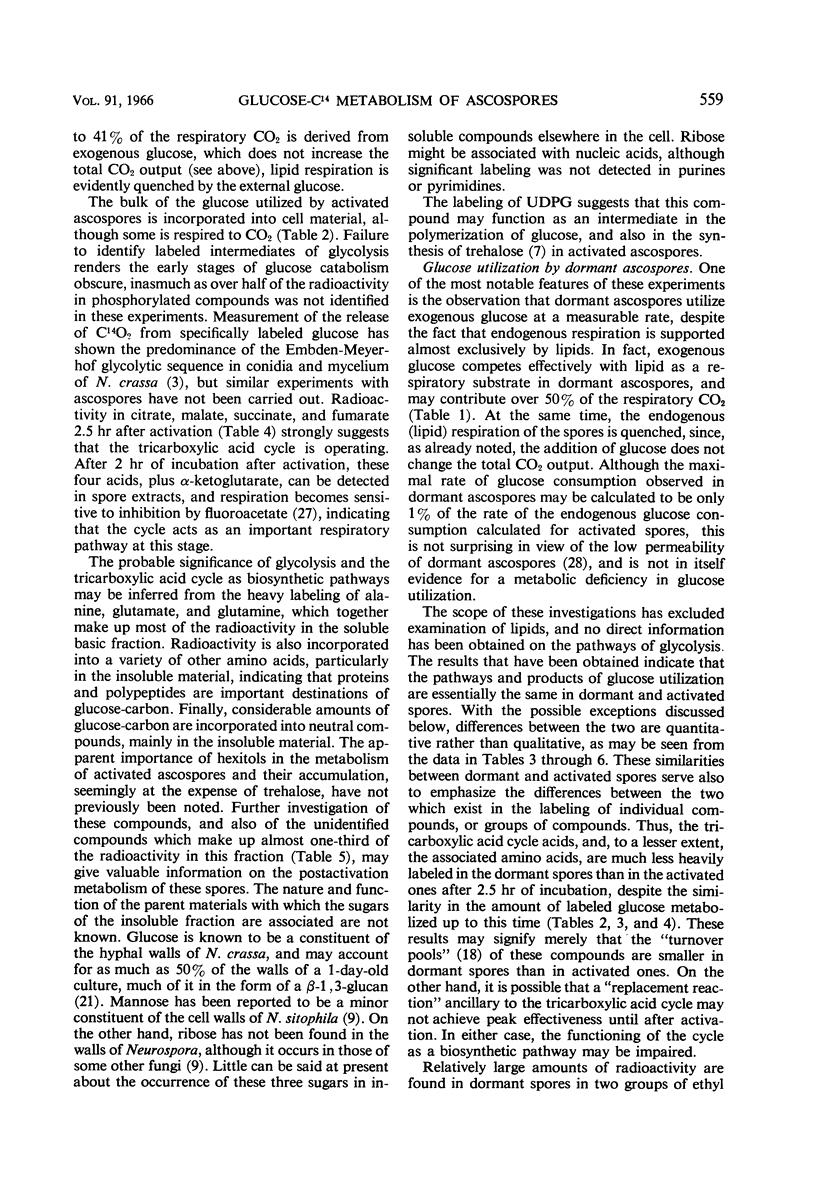
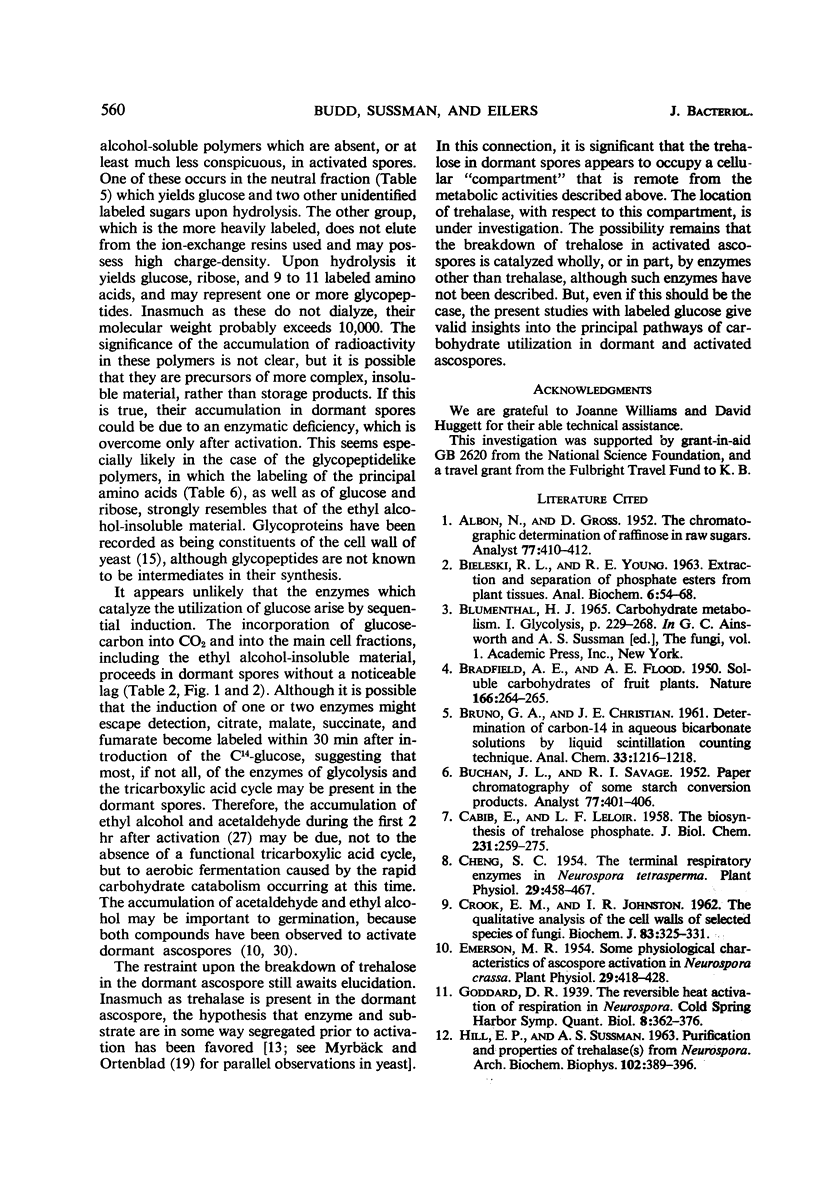
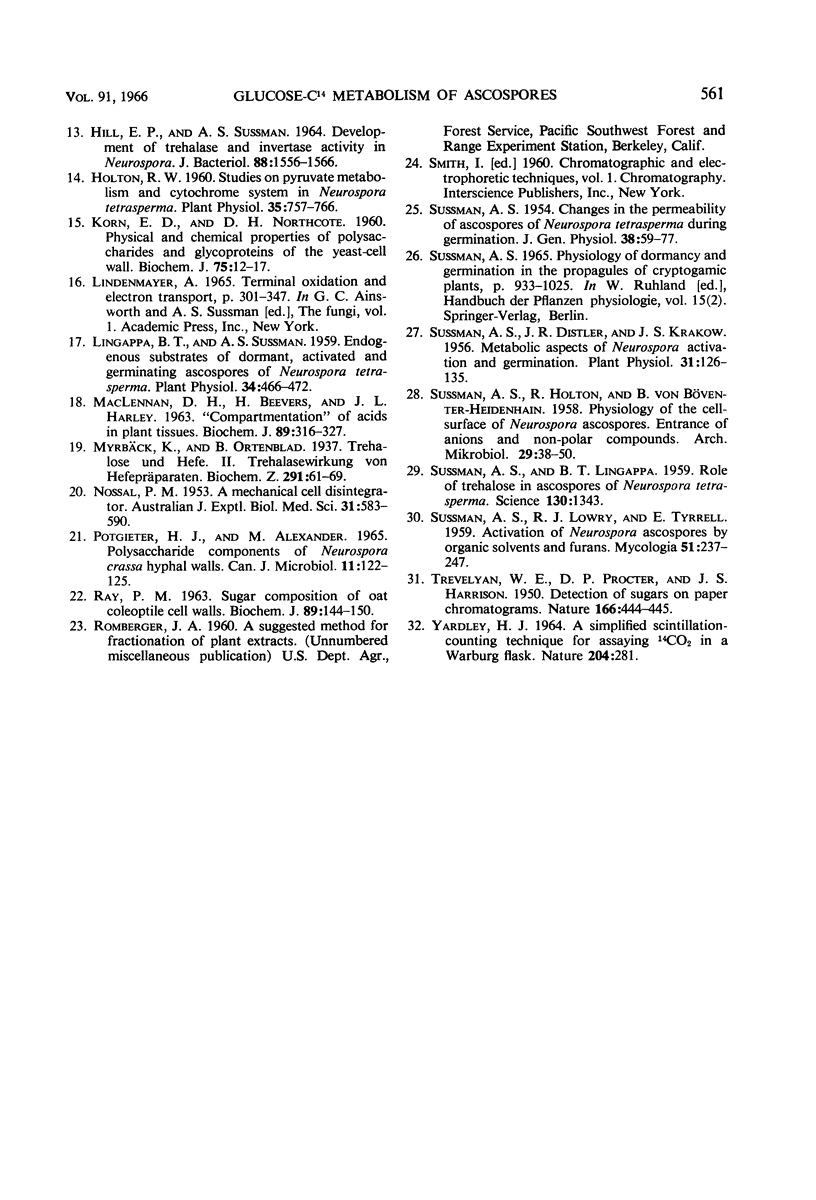
Selected References
These references are in PubMed. This may not be the complete list of references from this article.
- BRADFIELD A. E., FLOOD A. E. Soluble carbohydrates of fruit plants. Nature. 1950 Aug 12;166(4215):264–265. doi: 10.1038/166264a0. [DOI] [PubMed] [Google Scholar]
- CABIB E., LELOIR L. F. The biosynthesis of trehalose phosphate. J Biol Chem. 1958 Mar;231(1):259–275. [PubMed] [Google Scholar]
- CROOK E. M., JOHNSTON I. R. The qualitative analysis of the cell walls of selected species of fungi. Biochem J. 1962 May;83:325–331. doi: 10.1042/bj0830325. [DOI] [PMC free article] [PubMed] [Google Scholar]
- Cheng S. C. The Terminal Respiratory Enzymes in Neurospora Tetrasperma. Plant Physiol. 1954 Sep;29(5):458–467. doi: 10.1104/pp.29.5.458. [DOI] [PMC free article] [PubMed] [Google Scholar]
- Emerson M. R. Some Physiological Characteristics of Ascospore Activation in Neurospora crassa. Plant Physiol. 1954 Sep;29(5):418–428. doi: 10.1104/pp.29.5.418. [DOI] [PMC free article] [PubMed] [Google Scholar]
- HILL E. P., SUSSMAN A. S. DEVELOPMENT OF TREHALASE AND INVERTASE ACTIVITY IN NEUROSPORA. J Bacteriol. 1964 Dec;88:1556–1566. doi: 10.1128/jb.88.6.1556-1566.1964. [DOI] [PMC free article] [PubMed] [Google Scholar]
- HILL E. P., SUSSMAN A. S. PURIFICATION AND PROPERTIES OF TREHALASE (S) FROM NEUROSPORA. Arch Biochem Biophys. 1963 Sep;102:389–396. doi: 10.1016/0003-9861(63)90246-7. [DOI] [PubMed] [Google Scholar]
- Holton R. W. Studies on Pyruvate Metabolism and Cytochrome System in Neurospora Tetrasperma. Plant Physiol. 1960 Sep;35(5):757–766. doi: 10.1104/pp.35.5.757. [DOI] [PMC free article] [PubMed] [Google Scholar]
- KORN E. D., NORTHCOTE D. H. Physical and chemical properties of polysaccharides and glycoproteins of the yeast-cell wall. Biochem J. 1960 Apr;75:12–17. doi: 10.1042/bj0750012. [DOI] [PMC free article] [PubMed] [Google Scholar]
- Lingappa B. T., Sussman A. S. Endogenous Substrates of Dormant, Activated and Germinating Ascospores of Neurospora Tetrasperma. Plant Physiol. 1959 Jul;34(4):466–472. doi: 10.1104/pp.34.4.466. [DOI] [PMC free article] [PubMed] [Google Scholar]
- Maclennan D. H., Beevers H., Harley J. L. 'Compartmentation' of acids in plant tissues. Biochem J. 1963 Nov;89(2):316–327. doi: 10.1042/bj0890316. [DOI] [PMC free article] [PubMed] [Google Scholar]
- NOSSAL P. M. A mechanical cell disintegrator. Aust J Exp Biol Med Sci. 1953 Dec;31(6):583–589. doi: 10.1038/icb.1953.64. [DOI] [PubMed] [Google Scholar]
- POTGIETER H. J., ALEXANDER M. POLYSACCHARIDE COMPONENTS OF NEUROSPORA CRASSA HYPHAL WALLS. Can J Microbiol. 1965 Feb;11:122–125. doi: 10.1139/m65-017. [DOI] [PubMed] [Google Scholar]
- Ray P. M. Sugar composition of oat-coleoptile cell walls. Biochem J. 1963 Oct;89(1):144–150. doi: 10.1042/bj0890144. [DOI] [PMC free article] [PubMed] [Google Scholar]
- SUSSMAN A. S. Changes in the permeability of ascospores of Neurospora tetra-sperma during germination. J Gen Physiol. 1954 Sep 20;38(1):59–77. doi: 10.1085/jgp.38.1.59. [DOI] [PMC free article] [PubMed] [Google Scholar]
- SUSSMAN A., HOLTON R., VON BOVENTER-HEIDENHAIN B. [Physiology of the cell surface of Neurospora ascospores; entrance of anions and non-polar compounds]. Arch Mikrobiol. 1958;29(1):38–50. doi: 10.1007/BF00418735. [DOI] [PubMed] [Google Scholar]
- Sussman A. S., Distler J. R., Krakow J. S. Metabolic Aspects of Neurospora Activation and Germination. Plant Physiol. 1956 Mar;31(2):126–135. doi: 10.1104/pp.31.2.126. [DOI] [PMC free article] [PubMed] [Google Scholar]
- Sussman A. S., Lingappa B. T. Role of Trehalose in Ascospores of Neurospora Tetrasperma. Science. 1959 Nov 13;130(3385):1343–1343. doi: 10.1126/science.130.3385.1343. [DOI] [PubMed] [Google Scholar]
- TREVELYAN W. E., PROCTER D. P., HARRISON J. S. Detection of sugars on paper chromatograms. Nature. 1950 Sep 9;166(4219):444–445. doi: 10.1038/166444b0. [DOI] [PubMed] [Google Scholar]


